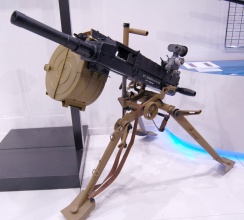AG-30 (30 mm)
Contents
Description
Write an introduction to the article in 2-3 small paragraphs. Briefly tell us about the history of the development and combat using the weaponry and also about its features. Compile a list of air, ground, or naval vehicles that feature this weapon system in the game.
Vehicles equipped with this weapon
General info
Tell us about the tactical and technical characteristics of the cannon or machine gun.
Available ammunition
Describe the shells that are available for the weapon and their features and purpose. If it concerns autocannons or machine guns, write about different ammo belts and what is inside (which types of shells).
Comparison with analogues
Give a comparative description of cannons/machine guns that have firepower equal to this weapon.
Usage in battles
Describe the cannon/machine gun in the game - its distinctive features, tactics of usage against notable opponents. Please don't write a "guide" - do not impose a single point of view, but give the reader food for thought.
Pros and cons
Pros:
- Decent rate of fire (400 RPM) in terms of an automatic grenade launcher
- May damage and cripple modules that are important to the enemy, such as their gun barrel and tracks
- Can remove enemy armor plates, especially ERA plates, so that the primary armament will have a better chance of penetrating
- If enemy compartment is open-back or open-top, the crew of the enemy will be eliminated within a single good burst
- Large belt capacity allows sustained fire for longer durations (300 grenades for the BMP-2M)
- Surprisingly, the grenades don't drop that much, so firing at far-away stationary targets won't be that much of a problem
- Launcher has decent elevation angles
Cons:
- Grenades will almost never penetrate armor directly and hurt the crew inside
- Grenade launcher cannot be selected via the weapon selection controls to be used and aimed independently of other weapon systems
- Grenade launcher does not have access to its own sights to be able to account for the grenade's unique trajectory, requiring the use of the gunner's high velocity gun sight (tip: the 30 km range notch in the primary gun sight is ranged roughly 250 m for the grenade launcher)
- Grenade's low muzzle velocity results in quite a delay from firing to grenade impact
- Time of travel can be ~1 second at 250 meters, and ~3 seconds at 500 meters, and expect even more time needed for targets beyond 500 m
- The very low muzzle velocity will make it a challenge to hit any moving targets beyond 200 m
History
The AGS-17 adopted in 1971 was improved upon with the introduction of the AGS-30 grenade launcher.[1] The new launcher, which had development started in the early 1990s by the KBP Instrument Design Bureau, was introduced in 1999 as a lighter, more accurate, and farther-hitting grenade launcher compared to the AGS-17, [2] as well as constructed with 40% fewer parts.[3]
The AGS-30 (Avtomatischeskyi Granatmyot Stankovyi Automatic Grenade Launcher - Mounted) was adopted for Russian Army service in 2002, firing the same 30 mm grenades as the AGS-17 in belts. A crew of two can carry the lightweight AGS-30 for use in the infantry role, mounted on a tripod when in use. The AGS-30 can also be found as vehicle mounts as the AG-30M on AFV and helicopters with a remote-controlled turret.[1]
The AGS-30 is still in service today, alongside the AGS-17 grenade launcher that it was intended to replace.[4]
Media
Excellent additions to the article would be video guides, screenshots from the game, and photos.
See also
- M129 (40 mm) - A similar vehicle-mounted grenade launcher
External links
- References
- Bibliography
- Army Recognition, "AGS-30 30mm automatic grenade launcher." Army Recognition, Army Recognition Group SPRL, 09 Oct. 2018, Website. Accessed 22 Apr. 2021 (Archive).
- Military-Today. "AGS-30" Military-Today, Website. Accessed on 22 Apr 2021 (Archive).
- Popenker, Maxim, "AGS-30." Modern Firearms, Website. Accessed 22 Apr. 2021 (Archive).
- TASS, "Russian arms manufacturer to launch production of AGS-30 grenade launchers in 2020." Russian News Agency TASS, 20 Aug. 2019, Website. Accessed 22 Apr. 2021 (Archive from 08 Nov 2020).
| USSR tank cannons | |
|---|---|
| 20 mm | TNSh |
| 30 mm | 2A42 · 2A72 · AG-30 |
| 45 mm | 20-K |
| 57 mm | AU-220 · Ch-51M · ZIS-2 · ZIS-4 · ZIS-4M |
| 73 mm | 2A28 |
| 76 mm | 1902/30 · 3-K · D-56TS · F-32 · F-34 · F-96 · KT-28 · L-10 · L-11 · ZIS-3 · ZIS-5 |
| 85 mm | D-5S · D-5T · D-58 · D-70 · F-30 · ZIS-S-53 |
| 100 mm | 2A48 · 2A70 · D-10S · D-10T · D-10T2S · D-50 · LB-1 · S-34 |
| 107 mm | ZIS-6 |
| 115 mm | U-5TS |
| 122 mm | A-19 · D-25-44T · D-25S · D-25T · D-25TS · D-30T · D-49 · M-30 · M-62-T2S |
| 125 mm | 2A26 · 2A46 · 2A46M · 2A46M-1 · 2A46M-4 · 2A46M-5 · 2A46MS · 2A75 · D-126 |
| 130 mm | B-13 · C-70 · M-65 |
| 152 mm | 2A33 · LP-83 · M-10T · M-64 · M-69 · ML-20S |
| Foreign: | |
| 37 mm | M5 (USA) |
| 50 mm | KwK L/42 (Germany) |
| 57 mm | 6pdr OQF Mk.III (Britain) · M1 (USA) |
| 75 mm | KwK42 (Germany) · M2 (USA) |
| 76 mm | M1 (USA) |
| 85 mm | Type-62-85-TC (China) |




